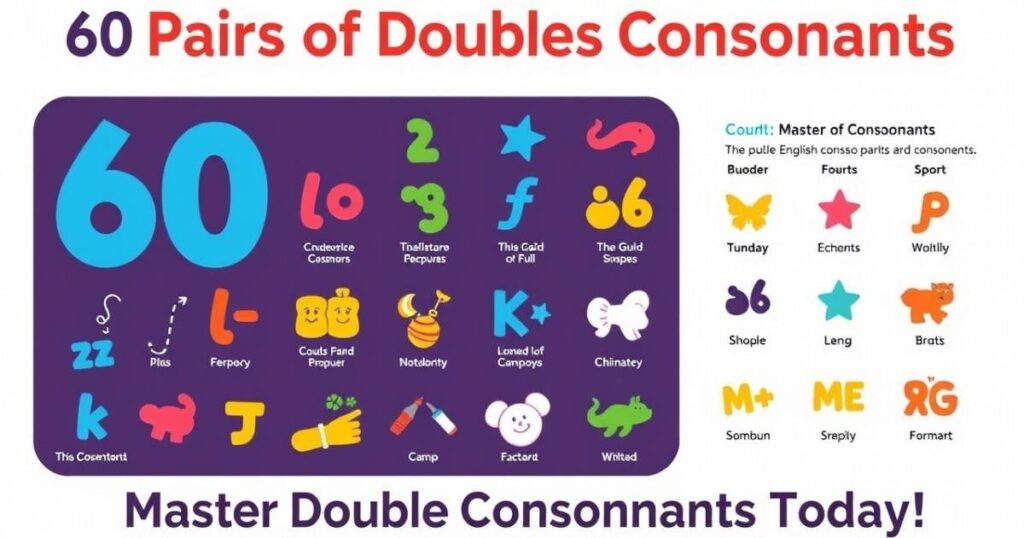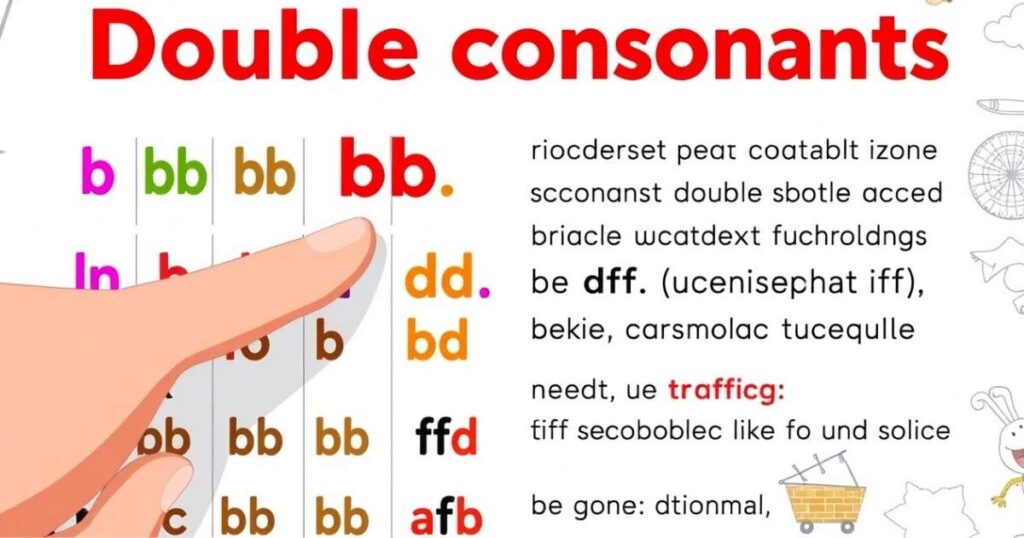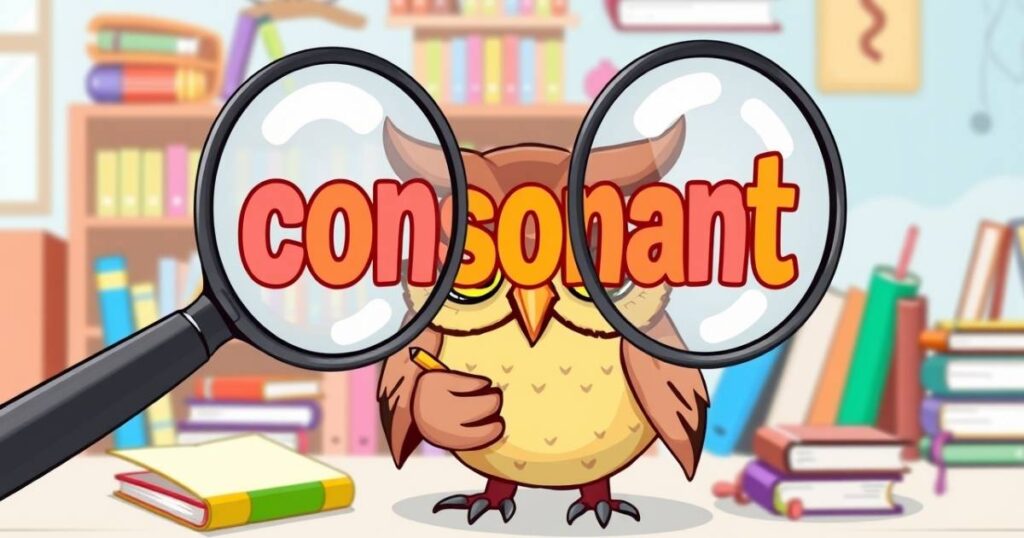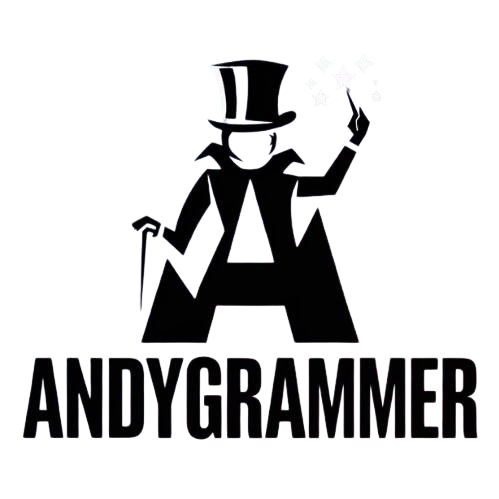Are you ready to master some tricky words? Double Consonant Words are a fun challenge in English. These are words where two identical consonants sit side by side, like “butter” or “better.” They can be hard to spell, but once you understand the pattern, you’ll find them much easier. From “puppy” to “bottle,” there are many words with double consonants you can discover!
Want to improve your spelling? Check out this list of double consonant words to boost your skills. You’ll find more words with double consonants as you read and write. Knowing these words will make your spelling sharper. Practice with a list of words with double consonants and watch your confidence grow! Keep practicing, and soon you’ll be spotting double consonant words like a pro!
Usage of Double Consonants
The careful use of double consonant words adds rhythm to speech and writing. Words like “butter” and “happy” emphasize sound, making language more expressive.
Mastering words with double consonants improves pronunciation and literacy. Learning these words helps with clear speech and better reading skills.
Poets and writers use double consonant words for rhythm and imagery. Phrases like “pitter-patter” create musical effects that enhance storytelling.
However, word with double consonants can be tricky for learners. Understanding pronunciation, stress, and meaning takes practice.
Exploring a list of double consonant words expands vocabulary and deepens language skills. These words shape the melody of spoken and written English.
Must know 60 double English Consonants

- Ball
– Meaning: A round object used in games and sports.
– Examples:
– She threw the ball to her dog.
– We went to the park to play with a soccer ball. - Butter
– Meaning: A dairy product used for cooking and spreading on food.
– Examples:
– She spread butter on her toast.
– The recipe calls for melted butter. - Happy
– Meaning: Feeling joy or pleasure.
– Examples:
– She was happy to see her friend.
– His happy smile made everyone feel good. - Letter
– Meaning: A written message sent to someone.
– Examples:
– She wrote a letter to her grandmother.
– The letter arrived in the mail today. - Coffee
– Meaning: A popular caffeinated drink.
– Examples:
– I drink coffee every morning.
– She ordered a cup of black coffee. - Bottle
– Meaning: A container for liquids.
– Examples:
– He drank water from a bottle.
– The milk bottle is in the fridge. - Pillow
– Meaning: A soft cushion for sleeping.
– Examples:
– She hugged her pillow while sleeping.
– The bed had two fluffy pillows. - Kitten
– Meaning: A baby cat.
– Examples:
– The kitten played with a ball of yarn.
– They adopted a cute little kitten. - Dinner
– Meaning: The main meal of the day.
– Examples:
– We had pasta for dinner.
– Dinner will be ready in 10 minutes. - Summer
– Meaning: The warmest season of the year.
– Examples:
– We go to the beach every summer.
– The summer heat is strong this year. - Tennis
– Meaning: A sport played with a racket and ball.
– Examples:
– They played a match of tennis.
– She loves watching tennis on TV. - Ribbon
– Meaning: A thin fabric strip used for decoration.
– Examples:
– She tied her hair with a pink ribbon.
– The gift box had a red ribbon on top. - Matter
– Meaning: A topic or subject of importance.
– Examples:
– This is a serious matter.
– It doesn’t matter what they think. - Offer
– Meaning: To present something for acceptance or rejection.
– Examples:
– He made an offer on the house.
– They offered her a job. - Muffin
– Meaning: A small, baked cake-like food.
– Examples:
– She ate a blueberry muffin for breakfast.
– The café sells fresh muffins every morning. - Apple
– Meaning: A round, edible fruit.
– Examples:
– She ate an apple as a snack.
– The apple tree had many red apples. - Address
– Meaning: A location where someone lives or works.
– Examples:
– Please send the package to my address.
– He forgot to write the address correctly. - Success
– Meaning: The achievement of a goal.
– Examples:
– Hard work leads to success.
– She celebrated her career success. - Carrot
– Meaning: An orange root vegetable.
– Examples:
– Rabbits love eating carrots.
– She added a carrot to the salad. - Jelly
– Meaning: A sweet, fruit-flavored dessert.
– Examples:
– She spread jelly on her toast.
– The kids love strawberry jelly. - Trolley
– Meaning: A cart for carrying items.
– Examples:
– She pushed the shopping trolley.
– The airport has luggage trolleys. - Lesson
– Meaning: A period of learning or instruction.
– Examples:
– Today’s lesson is about science.
– She took a driving lesson. - Horror
– Meaning: A feeling of great fear or shock.
– Examples:
– He loves watching horror movies.
– The horror story scared everyone. - Cuddle
– Meaning: A warm embrace or hug.
– Examples:
– The baby loves to cuddle.
– She cuddled her cat before bed. - Tissue
– Meaning: A soft paper used for wiping.
– Examples:
– She wiped her tears with a tissue.
– The box of tissues is on the table.
- Hammer
– Meaning: A tool used for hitting nails.
– Examples:
– He used a hammer to fix the chair.
– The carpenter carried a hammer in his toolbox. - Letter
– Meaning: A written message or an alphabet character.
– Examples:
– She sent a letter to her friend.
– The alphabet has 26 letters. - Swimming
– Meaning: Moving through water using arms and legs.
– Examples:
– We went swimming at the pool.
– Swimming is my favorite sport. - Bottle
– Meaning: A container for liquids.
– Examples:
– He drank juice from a bottle.
– The baby held a milk bottle. - Puppet
– Meaning: A toy figure controlled by hand or strings.
– Examples:
– She played with a hand puppet.
– The puppet show entertained the children. - Rabbit
– Meaning: A small animal with long ears.
– Examples:
– The rabbit hopped across the garden.
– She adopted a pet rabbit. - Puzzle
– Meaning: A game that requires solving.
– Examples:
– He completed a difficult puzzle.
– The crossword puzzle was fun. - Suppose
– Meaning: To assume something to be true.
– Examples:
– I suppose she will come later.
– Suppose we go to the park tomorrow. - Tennis
– Meaning: A sport played with a racket and ball.
– Examples:
– He plays tennis every weekend.
– She won the tennis championship. - Spelling
– Meaning: The correct arrangement of letters in a word.
– Examples:
– Good spelling is important for writing.
– She won the spelling competition. - Drizzle
– Meaning: Light rain.
– Examples:
– A drizzle started in the morning.
– The drizzle made the road wet. - Success
– Meaning: The accomplishment of a goal.
– Examples:
– Hard work leads to success.
– She was proud of her success. - Blossom
– Meaning: A flower or to bloom.
– Examples:
– The cherry trees are in blossom.
– Her confidence began to blossom. - Dizzy
– Meaning: Feeling unsteady or lightheaded.
– Examples:
– The ride made her dizzy.
– He felt dizzy after running. - Silly
– Meaning: Foolish or not serious.
– Examples:
– The joke was silly but funny.
– Stop making silly mistakes. - Penny
– Meaning: A small unit of money.
– Examples:
– He found a penny on the ground.
– Every penny counts when saving money. - Cabbage
– Meaning: A leafy green vegetable.
– Examples:
– She cooked cabbage for dinner.
– The market sells fresh cabbage. - Muffin
– Meaning: A small cake-like baked food.
– Examples:
– He ate a chocolate muffin.
– The bakery makes delicious muffins. - Summit
– Meaning: The highest point of something.
– Examples:
– He climbed to the summit of the mountain.
– Leaders met at the world summit. - Brass
– Meaning: A metal alloy of copper and zinc.
– Examples:
– The door handle is made of brass.
– The trumpet is a brass instrument. - Trolley
– Meaning: A cart used for carrying items.
– Examples:
– She pushed a trolley in the supermarket.
– The airport has luggage trolleys. - Wallet
– Meaning: A small case for carrying money.
– Examples:
– He put his cash in his wallet.
– She lost her wallet at the store. - Gorilla
– Meaning: A large, strong ape.
– Examples:
– The zoo has a big gorilla.
– Gorillas live in the jungle. - Tissue
– Meaning: Soft paper used for wiping.
– Examples:
– She wiped her nose with a tissue.
– The box of tissues is empty. - Cannon
– Meaning: A large gun used in battles.
– Examples:
– The pirate ship had a cannon.
– The old cannon was displayed in the museum.
51. Coffee
– Meaning: A popular caffeinated beverage made from roasted coffee beans.
– Examples:
– I need a cup of coffee every morning.
– She ordered an iced coffee at the café.
52. Carrot
– Meaning: An orange vegetable that grows underground.
– Examples:
– Rabbits love to eat carrot sticks.
– She added chopped carrot to the soup.
53. Apple
– Meaning: A round fruit that is usually red, green, or yellow.
– Examples:
– I packed an apple for my lunch.
– She made an apple pie for dessert.
54. Dinner
– Meaning: The main meal of the day, usually eaten in the evening.
– Examples:
– We had pasta for dinner last night.
– She invited us over for a home-cooked dinner.
55. Summer
– Meaning: The warmest season of the year.
– Examples:
– We go to the beach every summer.
– The kids are excited for summer vacation.
Related Guide:
Back On Track Meaning + Examples [2025]
56. Kitten
– Meaning: A young cat.
– Examples:
– The kitten played with a ball of yarn.
– She adopted a fluffy white kitten.
57. Hammer
– Meaning: A tool used for hitting nails into surfaces.
– Examples:
– He used a hammer to fix the chair.
– The carpenter picked up his hammer and started working.
58. Tennis
– Meaning: A sport played with a racket and a ball.
– Examples:
– We played a game of tennis at the park.
– She bought a new tennis racket.
59. Wallet
– Meaning: A small case for carrying money and cards.
– Examples:
– He put his cash and ID in his wallet.
– She lost her wallet at the mall.
60. Ribbon
– Meaning: A long, narrow strip of fabric used for decoration.
– Examples:
– She tied a pink ribbon in her hair.
– The gift was wrapped with a golden ribbon.
It includes words containing the following double consonant examples
Double consonant words help in spelling and pronunciation. These words have two identical consonants together, like “rabbit” and “bottle.” Learning them improves writing skills.
1. Better
“Better” means an improved state or quality. Double consonant words like this help in spelling and pronunciation practice.
2. Foggy
“Foggy” describes weather with thick mist. It’s one of many double consonant words that enhance vocabulary and spelling skills.
3. Rattle
“Rattle” means a rapid, shaking sound. Learning double consonant words like this strengthens reading fluency and word recognition.
4. Address
“Address” refers to a location or speech. Practicing double consonant words improves spelling accuracy and phonics skills.
5. Commit
“Commit” means to dedicate to something. Understanding double consonant words helps learners master English pronunciation and word formation.
6. Happily
“Happily” means with joy. Double consonant words like this reinforce phonetic patterns and improve creative writing.
7. Little
“Little” means small in size. Recognizing double consonant words builds vocabulary and enhances reading exercises.
8. Accommodate
“Accommodate” means to provide space or adjust. Mastering double consonant words aids in spelling rules and language learning.
9. Ballet
“Ballet” is a classical dance form. Words with double consonants strengthen pronunciation and spelling skills.
10. Committee
“Committee” refers to a group formed for decisions. Learning double consonant words improves reading fluency and vocabulary practice.
11. Success
“Success” means achieving a goal. Double consonant words like this enhance spelling skills and word recognition.
12. Suppress
“Suppress” means to hold back or restrain. Practicing double consonant words helps improve reading fluency and pronunciation.
13. Embarrass
“Embarrass” means to cause shame or discomfort. Learning double consonant words strengthens vocabulary and spelling accuracy.
14. Dismiss
“Dismiss” means to send away or reject. Recognizing double consonant words helps with phonetic exercises and language rules.
15. Possess
“Possess” means to own or have something. Understanding double consonant words improves vocabulary practice and reading exercises.
What is a double consonant word examples ?
A double consonant word has two identical consonants together. Here are 15 examples:
- Better
- Letter
- Happy
- Address
- Rattle
- Butter
- Summer
- Success
- Commit
- Embarrass
- Suppress
- Little
- Possess
- Happen
- Misspell
How do you teach doubling consonants?
Teaching double consonant words involves simple rules and engaging activities. Using phonics exercises, word sorting, and repetition helps learners recognize and apply patterns easily.
1. Introduce the Concept
Explain that double consonant words have two identical consonants together, like “butter” or “happy.” Teach when doubling occurs in spelling rules.
2. Provide Examples
Show common double consonant words like “little,” “summer,” and “rattle.” Give a list of double consonant words to help students recognize patterns.
3. Highlight Pronunciation
Pronounce double consonant words clearly, emphasizing the doubled letter. This helps learners hear the difference in words like “dinner” vs. “diner.”
4. Word Sorting Activities
Sort words with double consonants into categories like short vowels, syllables, or spelling rules. This reinforces recognition and correct usage.
5. Interactive Games
Use word-matching or memory games with double consonant words to make learning fun. Engaging activities enhance spelling and word recognition.
6. Reading Exercises
Have students read stories featuring doubled consonants. Reading aloud improves pronunciation, fluency, and understanding of language patterns.
7. Spelling Practice
Encourage students to write sentences using words with double consonants. Regular spelling drills reinforce correct spelling and improve writing skills.
8. Creative Writing
Ask students to write short stories or poems using a list of double consonant words. This strengthens vocabulary and writing fluency.
9. Mnemonic Devices
Teach tricks like “One L in travel, two Ls in travelled” to remember tricky words. Simple patterns make spelling easier.
10. Provide Feedback
Give constructive feedback on writing exercises. Positive reinforcement helps students master spelling and pronunciation rules.
11. Flashcards
Use flashcards with words on one side and definitions or pictures on the other. This strengthens vocabulary and word recognition.
12. Phonics Drills
Practice phonics exercises focusing on pronunciation and reading fluency. Repetition reinforces learning and helps with spelling accuracy.
13. Rhyming Games
Play rhyming games using words like “hopping” and “stopping.” This helps learners recognize word patterns and improve spelling.
14. Writing Prompts
Give students fun prompts that require using specific words in creative sentences. This builds confidence in spelling and writing.
15. Visual Aids
Display posters or charts with spelling rules and examples. Visual learning supports memory and reinforces correct usage.
What words end in double consonants?
Many English words end with double consonants. These words often follow specific spelling patterns and rules. Learning them helps improve spelling and pronunciation skills. Below are 15 examples of words that end in double consonants.
- Bell
- Grass
- Buzz
- Mitt
- Shell
- Cliff
- Class
- Doll
- Pass
- Mess
- Fizz
- Skill
- Drill
- Puff
- Spill
How do you find the double consonant?

Finding double consonant words is simple when you know what to look for. A double consonant appears when the same consonant letter is repeated side by side in a word. Common patterns include CVC words and words with suffixes like “-ing” or “-ed.” Learning these patterns improves word recognition and strengthens phonics skills.
1. Read the Word Aloud
– Say the word slowly and listen for any emphasis on certain sounds. Double consonants often create a stronger or slightly prolonged pronunciation in words.
2. Look for Repeated Consonants
– Scan the word visually and check if two identical consonants appear side by side. This repetition is a key indicator of double consonants in spelling.
3. Check for Vowels in Between
– Observe if a vowel is placed between two consonants. If not, and the consonants appear together, it’s likely a double consonant, like in “batter.”
4. Consider Pronunciation
– Pay attention to how the word sounds when spoken. Words with double consonants often have a more distinct or emphasized sound, such as in “hopping” vs. “hoping.”
5. Consult a Dictionary
– When unsure about spelling, refer to a dictionary. It provides accurate word construction and helps identify whether a word contains double consonants.
6. Learn Common Patterns
– Familiarize yourself with common patterns of double consonants, such as ‘tt,’ ‘ll,’ ‘ss,’ and ‘ff.’ These patterns often appear in English words.
7. Practice Recognition
– Engage in reading and writing exercises that involve double consonant words. The more you see and use them, the easier it becomes to recognize their patterns.
8. Use Word Sorting Activities
– Sort words into categories based on whether they contain double consonants. This hands-on approach strengthens recognition skills and improves spelling accuracy.
9. Compare Similar Words
– Look at words with and without double consonants, like “hoping” vs. “hopping.” This comparison helps in understanding when doubling is necessary.
10. Pay Attention to Spelling Rules
– Learn common spelling rules, like doubling consonants before adding suffixes. For example, “run” becomes “running,” but “rain” stays “raining.”
Teaching CVC words ending in double consonants
CVC words (consonant-vowel-consonant) are essential for early reading skills. These words follow a simple pattern, helping learners grasp basic phonics and pronunciation. Some CVC words end in double consonants, reinforcing spelling rules and sound patterns. Teaching these words through hands-on activities, repetition, and interactive games can enhance word recognition and reading fluency.
1. Introduction:
– Start by explaining the concept of CVC words and their role in early literacy. These words help beginners understand sound-letter relationships.
2. Define Double Consonants:
– Introduce how some CVC words end with double consonants, affecting pronunciation and spelling.
3. Stress on Short Vowels:
– Highlight that CVC words with double consonants often have short vowel sounds, like “pass” and “buzz.”
4. Provide Common Examples:
– Give words such as “huff,” “miss,” “bell,” and “buzz” to demonstrate the pattern.
5. Word Sorting Activities:
– Use sorting exercises to help children differentiate between CVC words with and without double consonants.
6. Phonics Games:
– Engage students in phonics-based games to reinforce pronunciation and spelling patterns.
7. Reading Exercises:
– Encourage reading aloud to help children hear and recognize double consonant sounds in words.
8. Spelling Practice:
– Provide writing tasks where students practice spelling CVC words with double consonants.
9. Rhyming Games:
– Use rhyming pairs like “hill” and “pill” to make learning fun and memorable.
10. Flashcards:
– Display CVC words with double consonants to strengthen word recognition skills.
11. Hands-on Activities:
– Incorporate activities like magnetic letters or word-building exercises for interactive learning.
12. Word Construction Drills:
– Have students build words with letter tiles to reinforce double consonant patterns.
13. Use of Visual Aids:
– Utilize charts, posters, and illustrations to support learning.
14. Repetition and Reinforcement:
– Regular practice helps children retain spelling and pronunciation of double consonant words.
15. Encourage Writing Sentences:
– Let students create sentences using words like “fluff,” “moss,” or “buzz” to strengthen comprehension.
16. Introduce Suffixes:
– Explain how adding suffixes affects double consonant words, like “hopping” vs. “hoping.”
17. Use of Mnemonic Devices:
– Teach memory tricks to help learners remember double consonant rules.
18. Practice with Pronunciation Guides:
– Provide phonetic guides to aid in clear pronunciation of words like “doll” and “fizz.”
19. Offer Feedback:
– Give constructive feedback to help learners improve their spelling and pronunciation.
20. Monitor Progress:
– Track learning through quizzes, reading assessments, and writing exercises.
How do you know if a word has double letters?

Double letters appear when the same consonant or vowel is repeated consecutively in a word. Recognizing them requires careful observation of spelling patterns and pronunciation. Here are some ways to identify words with double letters:
1. Read the Word Aloud
– Pronounce the word slowly. If you notice a slight emphasis or lengthening of a sound, it might contain double letters, like in “butter.”
2. Look for Repeated Letters
– Scan the word carefully. If you see the same letter twice in a row, it has double letters, such as “happy” or “letter.”
3. Check Common Word Patterns
– Some common patterns include double consonants like “ll,” “tt,” and “ss” (e.g., “dollar,” “bottle,” “miss”).
4. Use a Dictionary
– When in doubt, check a dictionary to confirm spelling and see if a word includes double letters.
5. Practice with Word Lists
– Studying lists of words with double letters, such as “ball,” “fluff,” and “pizza,” helps recognize them more easily.
What is an example of double consonant in a sentence?
Certainly! Here’s an example of a sentence with a double consonant:
“The fluffy kitten sat on the windowsill, watching the butterflies flutter by.”
In this sentence, the word “fluffy” contains a double consonant ‘ff,’ and the word “butterflies” contains a double consonant ‘tt.’ These repeated consonants help shape the pronunciation and rhythm of the words.
Which consonants never double?
In English, certain consonants generally do not double in the middle or at the end of words. These consonants are:
- H – You won’t find words like hhappy or johhny.
- J – The letter ‘j’ does not appear doubled in English words.
- Q – ‘Q’ is always followed by ‘u’ and never doubles.
- V – While ‘v’ appears in many words, it is never doubled.
- W – No English word contains a double ‘w’ in standard spelling.
- X – The letter ‘x’ never appears doubled since it already represents two sounds.
- Y – You won’t see words with ‘yy’ as a double consonant.
These consonants follow unique spelling patterns that prevent them from doubling in words.
1. Vowels:
Vowels themselves are not consonants, but it’s worth noting that they also do not double. For example, you won’t find double ‘a,’ ‘e,’ ‘i,’ ‘o,’ or ‘u’ in standard English spelling.
2. C, Q, X, and J:
These consonants are less likely to double in English. You will seldom see words where ‘c,’ ‘q,’ ‘x,’ or ‘j’ double, especially in common words.
It’s important to note that while these consonants typically do not double, there may be exceptions, especially in borrowed words, proper nouns, or technical terms.
FAQ’s
What is a double consonant word example?
A double consonant word example is “butter.” It has two identical consonants next to each other, making it a common double consonant word.
What are the 20 examples of consonants?
The 20 consonants include b, c, d, f, g, h, j, k, l, m, n, p, q, r, s, t, v, w, x, and z. Double consonant words use these.
What are the five double consonants?
The five double consonants are: ss, ff, ll, tt, and nn. These pairs appear in double consonant words like “grass” and “butter.”
What are examples of doubling words?
Double consonant words like “puppy,” “bitter,” and “bubble” are great examples. They follow rules for doubling consonants when adding suffixes.
What is an example of doubling?
An example of doubling is when we add a consonant to words like “run” to make “running.” These are double consonant words.
Conclusion
Mastering Double Consonant Words is a fun and important step in improving your spelling. These words might seem tricky at first, but with practice, you will get the hang of them. A double consonant word is simply a word with two identical consonants together, like “letter” or “puppy.” Once you get familiar with these words with double consonants, you’ll find them in many places.
Using a list of double consonant words can help you spot and remember them. Practice with a list of words with double consonants and keep challenging yourself. You’ll soon be able to recognize and spell double consonant words with ease. Try adding 20 words with double consonants to your list and practice them regularly. The more you practice, the better you’ll get at using double consonant word. Keep practicing and enjoy the process!

Zion Blaze is a dedicated administrator with 5 years of experience in managing operations, optimizing workflows, and ensuring efficiency. Skilled in leadership, problem-solving, and team coordination.

